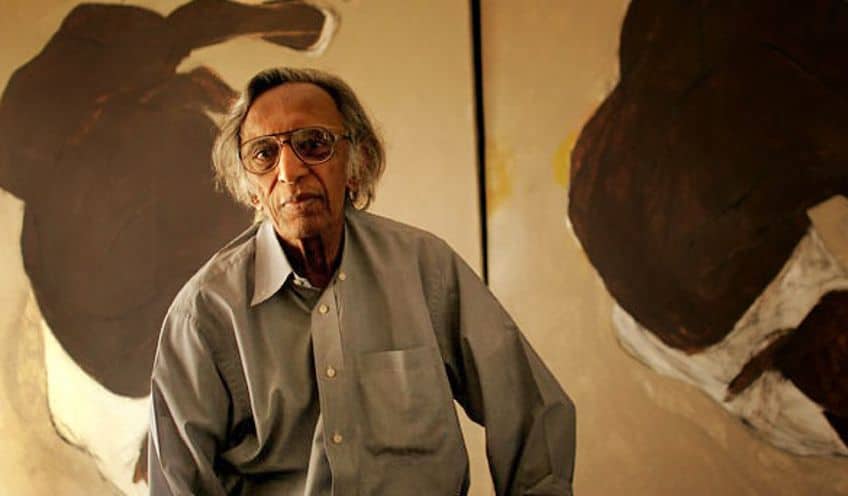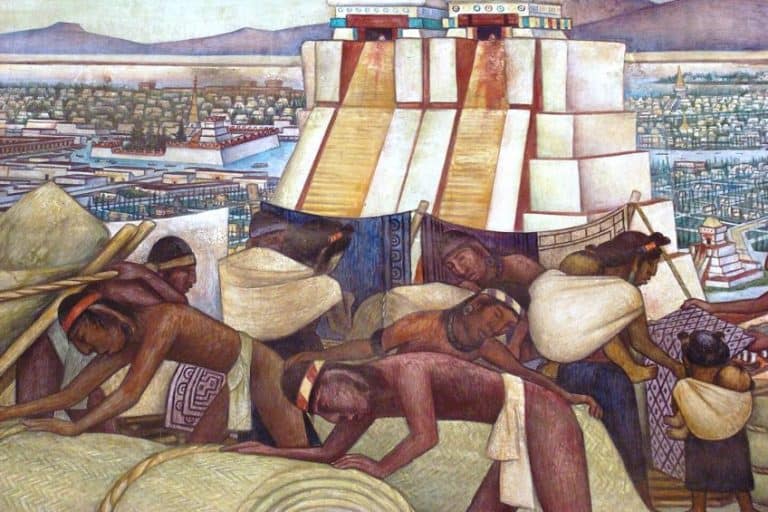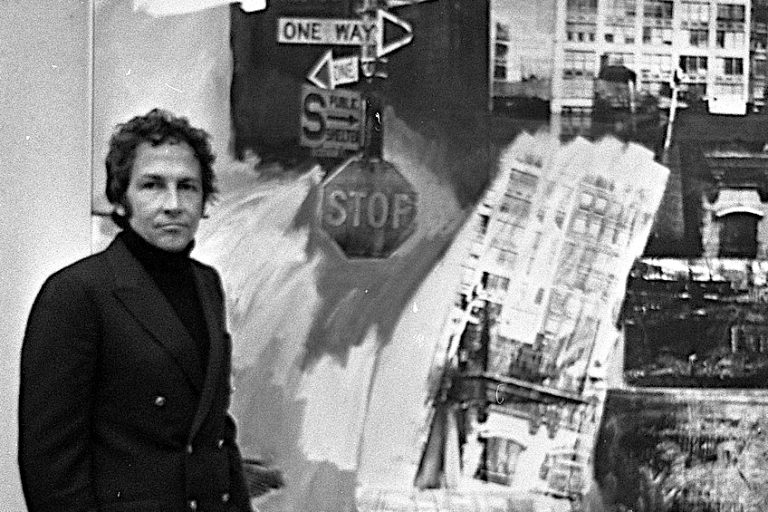Tyeb Mehta – A Central Figure in Abstract Indian Art
Tyeb Mehta, one of India’s most renowned modern artists, left an indelible mark on the art world with his powerful and emotive works. Born in 1925 in Gujarat, Mehta’s journey from a struggling artist to an iconic figure in Indian contemporary art is a testament to his talent and dedication. His signature style, characterized by bold lines, vibrant colors, and themes of anguish and human suffering, resonates deeply with viewers, offering profound insights into the human condition. Throughout his career, Mehta’s paintings, such as Trussed Bull and Celebration, have garnered international acclaim, making him a pivotal figure in the narrative of Indian art’s global recognition.
Key Takeaways
- Tyeb Mehta was a central figure in modern Indian art, known for expressive and abstract works.
- Mehta’s art frequently explored the themes of suffering and societal issues, deeply rooted in India’s history.
- Despite a private life, he achieved high recognition, earning top honors for his contribution to art.
Early Life and Education
| Birth | July 26, 1925 |
| Death | July 2, 2009 |
| Place of Birth | Kapadvanj, Gujarat, India |
| Genre of Work | Modern Indian art and Expressionism |
Tyeb Mehta holds a distinguished position among the pioneers of modern Indian art. Born in Gujarat, India, Mehta’s journey took him from the bustling city of Mumbai, where he was part of the influential Bombay Progressive Artists’ Group, to becoming an artist celebrated for his unique abstraction and evocative expressionism. His body of work reflects a blend of post-impressionist colors, cubist forms, and the brusqueness of expressionistic style. Not just a painter, Mehta extended his creativity to the realms of sculpting and filmmaking, adding depth to his artistic identity.

At the core of Mehta’s work are themes that traverse the complexity of human conditions and societal upheaval, most notably the violence and pain associated with the Partition of India. An accidental invention during his artistic exploration led to the acclaimed Diagonal Series, which showcased his ability to depict motion and tension through stark, angular lines. Mehta’s paintings often portrayed the struggles and resilience of individuals amidst chaos, making them profound reflections of his time and culture. Despite his reclusive nature, his artistry saw him receive prestigious accolades such as the Padma Bhushan and the Kalidas Samman.
Background and Childhood
Tyeb Mehta was born on July 26, 1925, in Kapadvanj, a town in Gujarat, to a Shi’ite Muslim family. His family relocated to Mumbai (formerly Bombay), where Mehta experienced his formative years amidst the bustling market area of Crawford Market.
The cultural diversity of Bombay along with the upheavals of the Partition period profoundly shaped his perspective.
Artistic Training
Mehta’s artistic inclinations led him to the Sir J.J. School of Art in Mumbai, where he immersed himself in the world of modern and contemporary art. During this time, he worked as a film editor at Famous Studios in Mumbai, an experience that honed his sense of visual narrative. Later, Mehta received a scholarship to travel to London, where he was particularly influenced by the works of Western artists like Francis Bacon.
Influence and Development
A pivotal figure in the formation of the Bombay Progressive Artists’ Group, Mehta contributed to the movement that marked the transition from traditional Indian art to modernism. His exposure to expressionistic styles in London and New York, combined with the support from the John D. Rockefeller 3rd Fund, enabled him to interact with the international art scene and refine his artistic language.
Artistic Themes
Mehta’s paintings frequently dealt with themes of violence, suffering, and the human condition—often reflecting on the Partition and its aftermath. His works like Diagonal, Trussed Bull, and Mahishasura employed powerful imagery to signify the underlying tension between Hindu and Muslim identities. Beyond his narrative on religious motifs, Mehta explored the dichotomy of violence and slaughter, producing pieces that spoke to a universal audience.
Development of Mehta’s Career
Tyeb Mehta’s career evolution mirrored the changing landscape of Indian art as he transitioned from a film editor to a renowned painter and sculptor. His works are deeply rooted in the cultural and political milieu of Bombay and he is a celebrated member of the Bombay Progressive Artists’ Group.
Recognition and Awards
Mehta garnered numerous accolades during his lifetime. Noteworthy among them was the Kalidas Samman given by the Madhya Pradesh Government. He also received the prestigious Padma Bhushan, India’s third-highest civilian award, recognizing his profound influence on Indian contemporary art.
International Exposure
In 1954, Mehta moved to London and immersed himself in the Western art scene for a decade. He was influenced by artists like Francis Bacon. His stay was pivotal as it exposed him to international styles.
He then blended these with Indian themes upon his return to Bombay.
Notable Works
Mehta’s paintings, noted for their bold strokes and emotive power, cover a wide range of subjects. His painting, Celebration, fetched a staggering figure at a Christie’s auction, setting a record for Modern Indian Art.
Iconic Series
Mehta is known for his thematic series that delved into the existential angst of human life. His Diagonal series initiated a unique style with diagonal divisions that became a significant motif, representing tension and division.
Legacy Pieces
One of Mehta’s most powerful pieces, Mahishasura, drew from Indian mythology and depicted the demon Mahishasura. This work showcased his signature style of minimalistic figures and became an emblematic piece of his legacy. Another seminal work, the Kali series, reflects his continuous engagement with themes of life and death.
Stylistic Evolution
This section explores the stylistic development of Tyeb Mehta, an acclaimed figure in Indian contemporary art known for his thematic innovation and significant impact at international auctions. Tyeb Mehta’s artistic style evolved over years from the influence of Indian traditions to incorporating elements of Modernism. He was notably part of the Bombay Progressive Artists’ Group, where he, along with peers like M.F. Husain, F.N. Souza, and S.H. Raza, sought to break away from the Nationalist Bengal school of art.
Mehta’s early work reflected post-impressionist colors and cubist forms leading to his distinctive style characterized by bold colors, starkly delineated forms, and powerful lines.
Distinctive Themes
His thematic repertoire was profoundly influenced by his experiences with violence and suffering, often incorporating diagonal compositions that became his hallmark in the Diagonal Series. Mehta’s narratives frequently portrayed falling figures and bodies, resonating the themes of tragedy and turmoil. His works, such as the Santiniketan Triptych Series and the powerful portrayal of Mahisasur—a reinterpretation of the demon-slaying Goddess Durga—underscored mythological and existential dichotomies.
Prominent Auctions
Tyeb Mehta’s masterpieces have fetched substantial sums at prominent auctions. Christie’s auction house sold his work, Mahishasura, for a record price, highlighting the high demand for his pieces. Saffronart has also featured his art, with several of his paintings commanding prices that underscore his standing in the art market.

Critical Acclaim
The art world has recognized Mehta’s contributions through multiple awards and honors. These accolades include the Prix Nationale at the Biennale de Paris, the prestigious Dayawati Modi Foundation Award, and, reflecting his early tie to film, the Filmfare Critics Award. His work has not only been a subject of academic study but continues to influence contemporary Indian art and is displayed in numerous galleries and exhibitions globally.
Influence and Impact
Tyeb Mehta’s legacy in the Indian art scene is monumental, leaving a deep influence on his peers and shaping future generations with his expressive and distinct style that bridged themes of violence and suffering with a vibrant color palette. He was a key member of the Bombay Progressive Artists’ Group, which spearheaded the movement of modern art in post-independence India.
Mehta’s approach to color and form brought an expressionistic edge to Indian painting, which had largely been dominated by traditional and nationalist themes prior to his emergence.
Legacy and Recognition
Tyeb Mehta is revered for his contemporary contributions to Indian art. Over the years, his work has been internationally recognized, with prestigious accolades such as the Padma Bhushan and the Kalidas Samman to his name. His painting, Celebration, fetched a record price on an international platform, illustrating his lasting appeal in the art world.
Influence on Peers
Mehta’s contemporaries, including M.F. Husain, F.N. Souza, and S.H. Raza, were also part of the Progressive Artists Group, with whom he shared ideas and a vision that propelled Indian modern art onto the global stage. As an artist-in-residence in several institutions, he directly impacted his peers through collaboration and exchange of ideas.

Impact on Future Generations
His dramatic use of form and a bold color palette influenced many contemporary Indian artists, who saw in his work a reflection of the post-colonial generation’s aspirations and struggle. Tyeb Mehta laid a foundation of expressionistic and contemporary Indian art that inspired artists to explore new narratives and mediums in their work.
Tyeb Mehta’s legacy endures as a beacon of artistic brilliance and emotional depth in the world of contemporary art. His ability to capture the complexities of human existence through bold strokes and vivid colors has left an indelible mark on Indian art and beyond. Mehta’s artworks continue to inspire and provoke thought, inviting viewers to delve into the depths of human emotions and societal struggles. As we reflect on his contributions, it becomes clear that Tyeb Mehta’s artistic vision and profound impact will resonate for generations to come, cementing his place among the pantheon of great artists whose work transcends boundaries and speaks to the universal human experience.
Frequently Asked Questions
What Artistic Movement Is Tyeb Mehta Associated With?
Tyeb Mehta is associated with Modernism, specifically as part of the Bombay Progressive Artists’ Group. His work broke away from the nationalist Bengal school and embraced modernist elements.
What Cultural Influences Are Evident in Tyeb Mehta’s Paintings?
His paintings reflect a harmonious blend of European expressionism and themes from Hindu mythological characters, often intertwined with real-life instances that convey a sense of struggle.
How Has Tyeb Mehta’s Style Evolved Over the Course of His Career?
Over his career, Mehta’s style evolved to incorporate post-impressionist colours, cubist forms, and expressionistic styles, with a focus on portraying themes like violence, suffering, and the human condition with intense emotional depth.
Isabella studied at the University of Cape Town in South Africa and graduated with a Bachelor of Arts majoring in English Literature & Language and Psychology. Throughout her undergraduate years, she took Art History as an additional subject and absolutely loved it. Building on from her art history knowledge that began in high school, art has always been a particular area of fascination for her. From learning about artworks previously unknown to her, or sharpening her existing understanding of specific works, the ability to continue learning within this interesting sphere excites her greatly.
Her focal points of interest in art history encompass profiling specific artists and art movements, as it is these areas where she is able to really dig deep into the rich narrative of the art world. Additionally, she particularly enjoys exploring the different artistic styles of the 20th century, as well as the important impact that female artists have had on the development of art history.
Learn more about Isabella Meyer and the Art in Context Team.
Cite this Article
Isabella, Meyer, “Tyeb Mehta – A Central Figure in Abstract Indian Art.” Art in Context. April 16, 2024. URL: https://artincontext.org/tyeb-mehta/
Meyer, I. (2024, 16 April). Tyeb Mehta – A Central Figure in Abstract Indian Art. Art in Context. https://artincontext.org/tyeb-mehta/
Meyer, Isabella. “Tyeb Mehta – A Central Figure in Abstract Indian Art.” Art in Context, April 16, 2024. https://artincontext.org/tyeb-mehta/.











